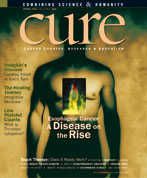v4n1 - Is It Really Hodgkin's Disease?
True Hodgkin’s disease is a relatively rare cancer that carries a high probability of a cure. However, the potential for cure is directly linked to receiving a correct diagnosis and staging evaluation.
In up to 60 percent of Hodgkin’s disease cases, the tumor is found in the area in the chest between the lungs and behind the breastbone, known as the mediastinum. However, there are many other tumors that can arise at this site, sometimes making correct diagnosis difficult. Moreover, the mediastinum is a particularly difficult location from which to get a high-quality biopsy sample, and because these tumors are relatively rare, many pathologists may not have extensive experience in examining these samples.
The best way to be sure of any cancer diagnosis is through immunohistochemistry (IHC, see CURE, Winter 2003). Each tumor has on its surface distinctive proteins that help identify the cancer. IHC is a process of staining or coloring the cells so that the unique tumor fingerprint can be shown and an accurate diagnosis made.
Below is a listing of tumor types that may be confused with Hodgkin’s disease. Patients diagnosed with Hodgkin’s disease or the following tumor types should consider seeking confirmation of an accurate diagnosis.
Mediastinal large B cell lymphoma (MLBCL)
Misdiagnosis of MLBCL is usually a case of confusion due to location because MLBCL is also found in the mediastinum. MLBCL is the most common non-Hodgkin’s lymphoma that arises in the mediastinum, occurring most frequently in women between the ages of 20 and 35. Considered an aggressive lymphoma, it is treated differently than Hodgkin’s disease but has a high cure rate if appropriately treated.
Anaplastic large cell lymphoma (ALCL)
This subtype of non-Hodgkin’s lymphoma can arise in the mediastinum. However, confusion can arise after biopsy because the cells look very similar to the Reed-Sternberg cells found with Hodgkin’s disease. IHC can help distinguish Hodgkin’s disease from ALCL. ALCL can also be cured in many patients with appropriate chemotherapy regimens.
